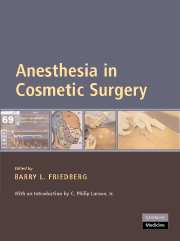Book contents
- Frontmatter
- Contents
- Foreword
- Acknowledgments
- Introduction
- Preface
- List of Contributors
- PART I MINIMALLY INVASIVE ANESTHESIA (MIA)Ⓡ FOR MINIMALLY INVASIVE SURGERY
- PART II ALTERNATIVE ANESTHESIA APPROACHES IN COSMETIC SURGERY
- PART III OTHER CONSIDERATIONS FOR ANESTHESIA IN COSMETIC SURGERY
- APPENDIX A A Guide to Perioperative Nutrition
- APPENDIX B Reflections on Thirty Years as an Expert Witness
- Index
Introduction
Published online by Cambridge University Press: 22 August 2009
- Frontmatter
- Contents
- Foreword
- Acknowledgments
- Introduction
- Preface
- List of Contributors
- PART I MINIMALLY INVASIVE ANESTHESIA (MIA)Ⓡ FOR MINIMALLY INVASIVE SURGERY
- PART II ALTERNATIVE ANESTHESIA APPROACHES IN COSMETIC SURGERY
- PART III OTHER CONSIDERATIONS FOR ANESTHESIA IN COSMETIC SURGERY
- APPENDIX A A Guide to Perioperative Nutrition
- APPENDIX B Reflections on Thirty Years as an Expert Witness
- Index
Summary
Anesthesiology has undergone remarkable changes in recent years. Among them is the development of anesthesia subspecialties and of anesthesiologists who focus most or all of their time in one area of anesthesia practice. This change has several advantages for patients, surgeons, and anesthesiologists. For one, the anesthesiologist learns the needs and expectations of the surgeon, which optimizes surgical outcome for patients. Furthermore, knowing what to expect, the anesthesiologist is better able to adjust both the doses and timing of drugs so that patients are adequately anesthetized for surgery but then emerge from anesthesia in a timely and comfortable manner. Nowhere are these issues more important than when surgery is performed in the ambulatory or office-based setting. Expectations are that patients undergoing surgery in these settings will go home the same day. Resources for extended care are usually nonexistent, as they should be.
Providing anesthesia for office- or clinic-basedcosmetic surgery has emerged as one subspecialty area for anesthesiologists. For patients, convenience is greatly enhanced and costs are greatly decreased in office- or clinic-basedcosmetic surgery. To provide the best anesthetic care in this specialized setting requires certain skills that are not emphasized in most anesthesia training programs. Fortunately, we are blessed with a resource prepared by a highly skilled and experienced anesthesiologist.
In this book, Dr. Barry L. Friedberg has assembled a compendium of his fifteen years of providing anesthesia care in the office setting. Where scientific documentation is available, Dr. Friedberg provides it.
- Type
- Chapter
- Information
- Anesthesia in Cosmetic Surgery , pp. xv - xviPublisher: Cambridge University PressPrint publication year: 2007

